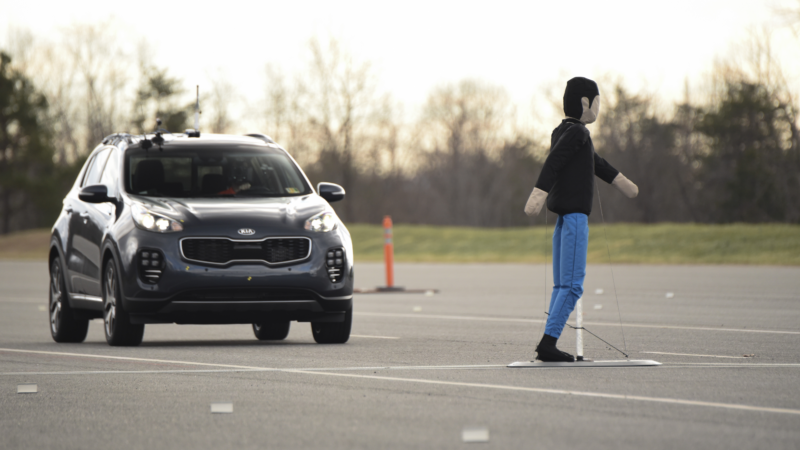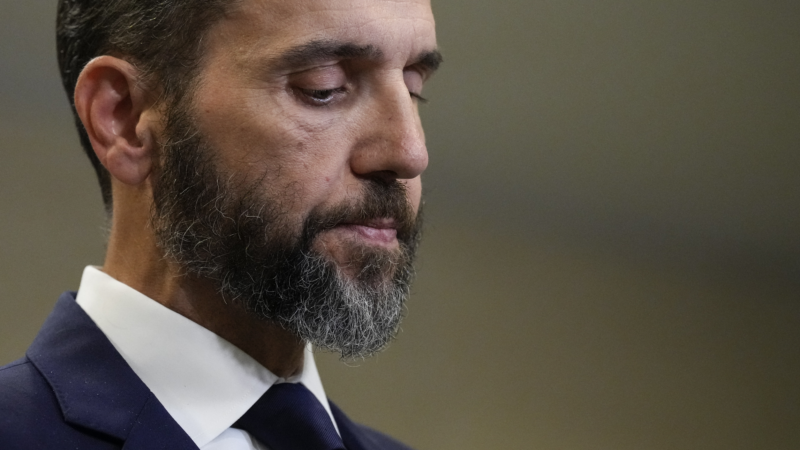Crash prevention technology shows ‘huge potential,’ but the roadmap is up for debate
RUCKERSVILLE, Va. — Automatic emergency braking is the kind of feature most drivers hope they never have to use.
But if you want to see it in action, there’s a place in central Virginia where test drivers push these systems to their limits all the time.
“What we’re going to do here is I’m going to drive at the target, maybe act like a distracted driver that maybe doesn’t see it,” said David Aylor, vice president for active safety testing at the Insurance Institute for Highway Safety.
Nearly a decade ago, IIHS built a special outdoor testing lab at its campus here to test how these crash prevention systems perform in real-world conditions. To demonstrate how it works, Aylor gets behind the wheel of a Mercedes-Benz SUV. He steers the car directly at a life-size dummy and accelerates steadily.
But suddenly, the car slams to a halt — stopping a few feet in front of the dummy.
A few years ago, Aylor says only a handful of automatic braking systems earned his team’s top rating. Now many do. These systems tend to perform worse at night, he says, but even that is getting better as cameras improve.
“We’ve seen in our testing over the last four or five years pretty big improvements in the performance of the vehicles,” Aylor said. “So I think this technology has huge potential.”

If you’ve bought a new car lately, it probably came loaded with safety features. The vast majority of cars now have automatic braking and other crash prevention technology built in.
Researchers say those systems are saving lives already and have the potential to save many more. But there’s still room for improvement — and debate about their future rollout.
“These systems have really infiltrated the new vehicle market,” said Jennifer Morrison, the head of vehicle safety for Mazda North America.
“The reason that that’s so impressive is that they’re not required. This is all voluntary,” Morrison said in an interview.
Back in 2016, automakers reached a voluntary agreement with federal regulators and safety advocates to put automatic emergency braking, or AEB, in their cars and trucks. For a while, crash prevention technology was confined largely to the higher end of the market. But now many of these technologies come standard in nearly all light-duty vehicles.
More than 94% of new vehicles in 2023 come with AEB, according to new research from the Partnership for Analytics Research in Traffic Safety, a collaboration between the auto industry and federal regulators. And several other driver-assistance technologies are now standard in more than 90% of new cars, trucks and SUVs.
The widespread adoption of crash prevention technology offers a glimmer of hope in what is otherwise a fairly bleak state of affairs. Car crashes kill more than 40,000 people a year in the U.S., including more than 7,000 pedestrians.
Those numbers climbed sharply during the pandemic, but they’ve dipped slightly over the last two years — a trend that continued in the first half of 2024, according to early estimates. And the widespread adoption of this technology is likely one reason why.
“It’s a big deal, because AEB can stop the car if someone is distracted, if someone is impaired, if someone is drowsy. And those are some of the biggest contributors to crashes,” said Cathy Chase, president of the non-profit Advocates for Highway and Auto Safety.
But Chase says there is still more work to do.

“There’s just a lot of question marks,” she said. “Just putting AEB into a car doesn’t mean ‘problem solved.'”
Chase and other safety advocates say they also want some basic standards to make sure these braking systems are performing as well as they should.
Regulators at the National Highway Traffic Safety Administration, or NHTSA, agreed. This year, the agency issued a final rule that makes AEB mandatory and sets new federal safety standards, starting with the 2029 model year.
But a trade group for the auto industry is pushing back against that regulation.
“This is virtually impossible to meet at this point,” said John Bozzella, president of the Alliance for Automotive Innovation. He argues that regulators are asking for too much — in part by requiring these braking systems to work at highway speeds of 45 miles per hour and above.
“What I’m concerned about is we’re going to make driving, especially highway driving, more erratic when we should be making it more predictable,” Bozzella said in an interview last month. “We’re going to trade a reduction in front-end collisions for an increase in rear-end collisions.”
Bozzella’s group and several automakers filed formal petitions asking NHTSA to reconsider the new AEB standards. But last week, regulators largely rejected those petitions.
Bozzella blasted that decision as “wrong” and “disastrous,” predicting that it would “frustrate drivers” and “make vehicles more expensive.”
“What a waste,” Bozzella said in a statement from the Alliance from Automotive Innovation. “A 10-year partnership with policymakers that put this lifesaving automotive technology in almost all new vehicles was just tossed aside.”
Safety advocates, meanwhile, supported the decision by regulators.
“It is a safety victory for all road users that most parts of the Petitions were denied,” Chase said in a statement last week. “In keeping the integrity of the Rule intact, NHTSA has safeguarded the most impactful regulation for roadway safety issued in years.”
But the debate over the AEB regulation may not be over yet. The Alliance for Automotive Innovation says it’s asking the incoming Trump administration to reconsider the rule once again, and to “foster a collaborative and solutions-oriented approach to roadway safety.”
A record 24 million people now get Obamacare health plans. Will it last under Trump?
Enrollment in Affordable Care Act health insurance plans has grown every year of the Biden administration, leading to a record high rate of people with insurance.
Tilda Swinton thinks about death and says you should, too
Swinton plays a woman dying of cancer in Pedro Almodóvar's The Room Next Door. "A life spent considering how we're going to spend our end is not wasted time," Swinton says.
Girl Scouts are retiring two cookie flavors (don’t worry, your Thin Mints are safe)
2025 will be the last time you can buy Girl Scout S'mores and Toast-Yay! cookies. They join the ranks of many other discontinued flavors — RIP Mango Cremes with Nutrifusion and cheesy Golden Yangles.
Here’s where things stand for several major landmarks in the Los Angeles fires
The fires raging across Los Angeles are putting some cultural institutions in danger.
Justice Department wants to release only part of its report on Trump cases
Prosecutors dropped the two criminal cases against Trump after he won the 2024 election, and the final report by Smith may be the last chance for prosecutors to explain their decisions.
Trump asks the Supreme Court to block his sentencing in hush money case
President-elect Donald Trump is scheduled to be sentenced on Jan. 10 in New York. His latest legal move to block sentencing comes after a New York appeals court rejected a similar appeal Tuesday.





